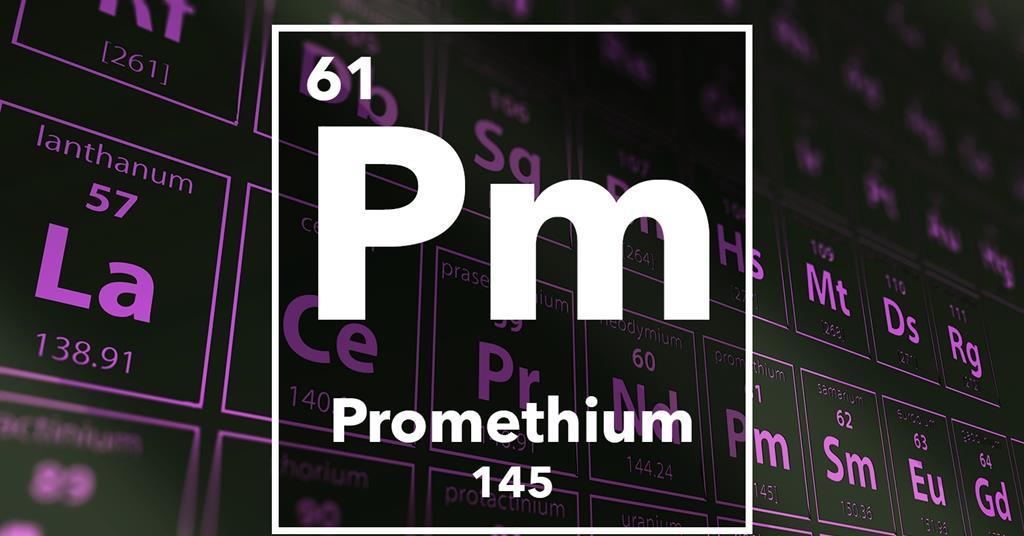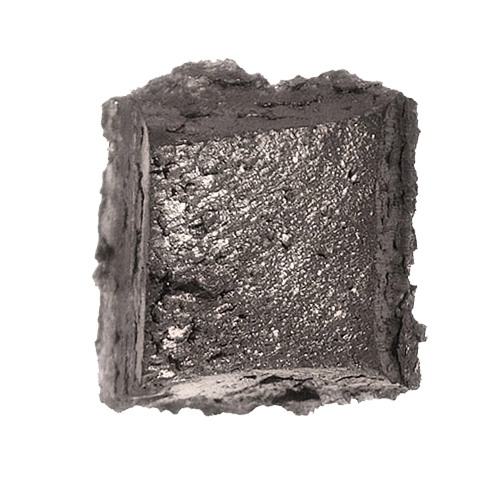Identity.
Promethium (Pm), element number 61, is a rare and radioactive oddity.
Unlike other lanthanides, it has no stable isotopes, existing only in
trace amounts naturally and produced artificially through nuclear
fission. This unique element emits faint beta radiation and boasts a
ghostly glow, finding use in specialized batteries, illuminated signs,
and potentially even future medical applications. Although handling
necessitates caution due to its radioactivity, promethium's scarcity
and intriguing properties solidify its place as a fascinating paradox
in the periodic table.
Atomic Structure:
The nucleus consists of 61 protons (red) and 84 neutrons (orange). 61
electrons (white) successively occupy available electron shells
(rings). Promethium is a lanthanide in period 6, and the f-block of
the periodic table. It melts at 1042 degrees Celsius.
History.
Promethium wasn't always just a name on the periodic table. Its
existence was long predicted, a theoretical gap waiting to be filled.
In 1902, chemist Bohuslav Brauner prophesied its presence, and decades
later, Henry Moseley confirmed the missing piece. Yet, capturing this
elusive element proved trickier than expected. Several teams claimed
success, but their discoveries remained unverified due to promethium's
fleeting nature.
Finally, in 1945, amidst the Manhattan Project, Jacob Marinsky,
Lawrence Glendenin, and Charles Coryell at Oak Ridge National
Laboratory achieved the feat. Hidden within the radioactive soup
of uranium fission products, they unearthed the first confirmed
traces of promethium. Initially kept secret due to wartime
priorities, the official announcement only came in 1947.
Aptly named after the mythological Prometheus, a symbol of stolen
fire and innovation, promethium quickly found applications. Its
long-lasting radioactive glow sparked its use in luminous dials,
later replaced due to safety concerns. But promethium's potential
extended beyond mere illumination. The element fueled miniature
nuclear batteries for pacemakers and space probes, offering a
flicker of power in the most remote corners. Though challenges
remain due to its scarcity and radioactivity, promethium's journey
from theorized gap to versatile tool continues, reminding us that
the pursuit of knowledge, like Promethean fire, can illuminate
even the darkest corners of the scientific landscape.
Usage.
Though rare and radioactive, promethium packs a powerful punch in its
unique uses. It casts an eerie glow in self-illuminating signs,
keeping us safe in darkness. Packed in tiny capsules, it fuels
long-lasting batteries powering everything from pacemakers to deep-sea
probes, defying distance and darkness with reliable power. Even the
future of medicine whispers with its potential, offering hope for
targeted cancer treatment. Promethium, a paradox of power and
scarcity, continues to illuminate unexpected corners of our world.
-
Long-Lasting Glow:Promethium's radioactive decay excites a
phosphor, creating the continuous glow in self-illuminating exit
signs, aircraft instruments, and even novelty keychains. These
applications, though declining due to safety concerns, showcase
its ability to provide reliable low-level light without external
power.
-
Compact Power:Packed within tiny capsules, promethium
powers specialized atomic batteries. These long-lasting,
maintenance-free energy sources fuel pacemakers, satellites, and
even deep-sea probes, offering reliable power in remote or
inaccessible locations where sunlight or traditional batteries
fall short.
-
Medical Potential: Beyond glow and power, promethium holds
promise in the medical field. Researchers are exploring its use in
radioimmunotherapy, where targeted particles deliver radiation
directly to cancer cells, potentially offering a more precise and
effective treatment option. While still in its early stages, this
application hints at promethium's future contribution to
healthcare.
Some of the benefits of using Neodymium are:
-
Promethium is radioactive, meaning it emits ionizing radiation
harmful to human health in excessive amounts. While its specific
applications are controlled and minimize exposure, it's inaccurate
to paint any radioactive element as inherently "beneficial."
-
Promethium is incredibly rare on Earth and primarily produced
artificially through nuclear fission. This scarcity makes
large-scale or everyday use impractical and economically
unfeasible.
-
Many applications of promethium, like self-illuminating signs,
have been replaced by safer and more sustainable alternatives like
non-radioactive luminescent materials.
-
Promethium's radioactive decay allows its use in nuclear
batteries, providing reliable power in remote and challenging
environments like pacemakers and deep-sea probes where traditional
batteries are impractical.
Sources.
Promethium boasts two unusual sources: cosmic whispers and atomic
echoes. In trace amounts, it arises from rare alpha decays of natural
europium and spontaneous uranium fission, leaving behind fleeting
signatures on Earth. However, promethium shines brighter in distant
stars like HR 465, where nuclear processes forge it in abundance,
offering scientists clues about stellar evolution. Most of our earthly
promethium comes from a different echo - the controlled thunder of
nuclear fission reactors. Here, it emerges amidst spent fuel,
requiring careful extraction to power long-lasting batteries and
specialized applications. So, promethium's story spans from the
vastness of space to the heart of reactors, reminding us that the
rarest treasures can be found in the most unexpected places.
Properties.
Radioactive: All isotopes of promethium are radioactive,
meaning they spontaneously emit beta particles and gamma rays. This
gives it unique applications in illumination and power sources, but
also necessitates careful handling due to safety concerns.
Rare Earth Meatal: Promethium belongs to the lanthanide series
of elements, sharing similar chemical properties like forming
trivalent cations and readily reacting with water and oxygen. However,
its scarcity and radioactivity set it apart from other lanthanides.
High Density and Mallability: Despite its rarity, promethium
exhibits several physical properties typical of metals. It's denser
than most other lanthanides and surprisingly malleable, meaning it can
be deformed without breaking. This makes it potentially useful for
specific applications where these properties are crucial.


 1.webp)